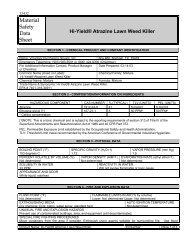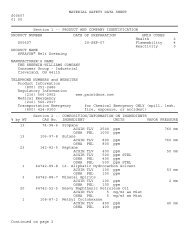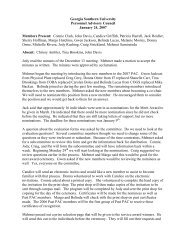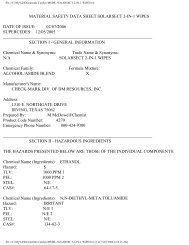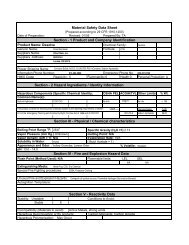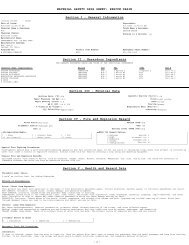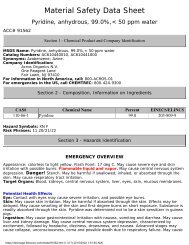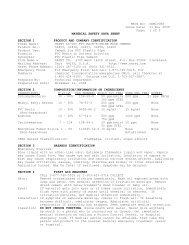Hydroxybenzotriazole, 98% - services
Hydroxybenzotriazole, 98% - services
Hydroxybenzotriazole, 98% - services
Create successful ePaper yourself
Turn your PDF publications into a flip-book with our unique Google optimized e-Paper software.
Material Safety Data SheetACC# 704461-<strong>Hydroxybenzotriazole</strong>, <strong>98%</strong>Section 1 - Chemical Product and Company IdentificationMSDS Name: 1-<strong>Hydroxybenzotriazole</strong>, <strong>98%</strong>Catalog Numbers: AC169160000, AC169160250, AC169161000Synonyms: HOBTCompany Identification:Acros Organics N.V.One Reagent LaneFair Lawn, NJ 07410For information in North America, call: 800-ACROS-01For emergencies in the US, call CHEMTREC: 800-424-9300Section 2 - Composition, Information on IngredientsCAS# Chemical Name Percent EINECS/ELINCS2592-95-2 1-<strong>Hydroxybenzotriazole</strong> 98.0 219-989-7Hazard Symbols: FRisk Phrases: 11 44Section 3 - Hazards IdentificationEMERGENCY OVERVIEWAppearance: white. Light sensitive. May cause respiratory and digestive tract irritation. Caution!May cause eye and skin irritation. Warning! Flammable solid. May cause central nervous systemeffects.Target Organs: Central nervous system.Potential Health EffectsEye: Dust may cause mechanical irritation. May cause lacrimation (tearing), blurred vision, andphotophobia. May cause chemical conjunctivitis and corneal damage.Skin: May cause skin irritation and possible burns.Ingestion: May cause irritation of the digestive tract. May cause nausea, vomiting, abdominal pain,and increased salivation.Inhalation: Inhalation of dust may cause respiratory tract irritation. Olfactory fatigue may occur.Can produce delayed pulmonary edema.Chronic: No information found.Section 4 - First Aid Measureshttps://fscimage.fishersci.com/msds/70446.htm (1 of 6) [3/1/2002 1:32:18 PM]
Eyes: Immediately flush eyes with plenty of water for at least 15 minutes, occasionally lifting theupper and lower eyelids. Get medical aid immediately.Skin: Get medical aid. Flush skin with plenty of soap and water for at least 15 minutes whileremoving contaminated clothing and shoes.Ingestion: Never give anything by mouth to an unconscious person. Get medical aid immediately.Do NOT induce vomiting. If conscious and alert, rinse mouth and drink 2-4 cupfuls of milk or water.Inhalation: Remove from exposure to fresh air immediately. If breathing is difficult, give oxygen.Get medical aid. Do NOT use mouth-to-mouth resuscitation. If breathing has ceased apply artificialrespiration using oxygen and a suitable mechanical device such as a bag and a mask.Notes to Physician: Treat symptomatically and supportively.Section 5 - Fire Fighting MeasuresGeneral Information: As in any fire, wear a self-contained breathing apparatus inpressure-demand, MSHA/NIOSH (approved or equivalent), and full protective gear. During a fire,irritating and highly toxic gases may be generated by thermal decomposition or combustion. Dustcan be an explosion hazard when exposed to heat or flame. Flammable solid. May burn rapidly withflare burning effect. May re-ignite after fire is extinguished. Containers may explode when heated.Risk of explosion if heated under confinement.Extinguishing Media: Use water spray to cool fire-exposed containers. For large fires, use waterspray, fog or regular foam. Contact professional fire-fighters immediately. For small fires, use drychemical, carbon dioxide, sand, earth, water spray or regular foam. Cool containers with floodingquantities of water until well after fire is out.Section 6 - Accidental Release MeasuresGeneral Information: Use proper personal protective equipment as indicated in Section 8.Spills/Leaks: Sweep up or absorb material, then place into a suitable clean, dry, closed containerfor disposal. Scoop up with a nonsparking tool, then place into a suitable container for disposal. Avoidgenerating dusty conditions. Remove all sources of ignition. Provide ventilation.Section 7 - Handling and StorageHandling: Wash thoroughly after handling. Minimize dust generation and accumulation. Avoidcontact with eyes, skin, and clothing. Empty containers retain product residue, (liquid and/or vapor),and can be dangerous. Keep container tightly closed. Avoid contact with heat, sparks and flame.Avoid ingestion and inhalation. Do not pressurize, cut, weld, braze, solder, drill, grind, or exposeempty containers to heat, sparks or open flames.Storage: Keep away from sources of ignition. Store in a tightly closed container. Store in a cool, dry,well-ventilated area away from incompatible substances.Section 8 - Exposure Controls, Personal ProtectionEngineering Controls: Facilities storing or utilizing this material should be equipped with anhttps://fscimage.fishersci.com/msds/70446.htm (2 of 6) [3/1/2002 1:32:18 PM]
eyewash facility and a safety shower. Use adequate general or local explosion-proof ventilation tokeep airborne levels to acceptable levels.Exposure LimitsChemical Name ACGIH NIOSH OSHA - Final PELs1-<strong>Hydroxybenzotriazole</strong> none listed none listed none listedOSHA Vacated PELs: 1-<strong>Hydroxybenzotriazole</strong>: No OSHA Vacated PELs are listed for this chemical.Personal Protective EquipmentEyes: Wear appropriate protective eyeglasses or chemical safety goggles as described by OSHA's eyeand face protection regulations in 29 CFR 1910.133 or European Standard EN166.Skin: Wear appropriate protective gloves to prevent skin exposure.Clothing: Wear appropriate protective clothing to prevent skin exposure.Respirators: Follow the OSHA respirator regulations found in 29CFR 1910.134 or EuropeanStandard EN 149. Always use a NIOSH or European Standard EN 149 approved respirator whennecessary.Section 9 - Physical and Chemical PropertiesPhysical State: SolidAppearance: whiteOdor: None reported.pH: Not available.Vapor Pressure: Not available.Vapor Density: Not available.Evaporation Rate:Not available.Viscosity: Not available.Boiling Point: Not available.Freezing/Melting Point:157 deg C decAutoignition Temperature: Not available.Flash Point: Not applicable.Decomposition Temperature:157 deg CNFPA Rating: (estimated) Health: 1; Flammability: 1; Reactivity: 2Explosion Limits, Lower:Not available.Upper: Not available.Solubility: 0.3% (20°C)Specific Gravity/Density:Not available.Molecular Formula:C6H5N3OMolecular Weight:135.12Section 10 - Stability and ReactivityChemical Stability: Stable. Heating above 180°C results in rapid exothermic decomposition.Heating may cause an explosion.Conditions to Avoid: Incompatible materials, ignition sources, dust generation, excess heat, strongoxidants, heating above the melting point (155-158°C).Incompatibilities with Other Materials: Strong oxidizing agents, copper nitrate.Hazardous Decomposition Products: Nitrogen oxides, carbon monoxide, irritating and toxic fumesand gases, carbon dioxide, nitrogen.Hazardous Polymerization: Has not been reported.https://fscimage.fishersci.com/msds/70446.htm (3 of 6) [3/1/2002 1:32:18 PM]
Section 11 - Toxicological InformationRTECS#:CAS# 2592-95-2: DM1288000LD50/LC50:CAS# 2592-95-2:Draize test, rabbit, eye: 100 mg Mild;Carcinogenicity:CAS# 2592-95-2: Not listed by ACGIH, IARC, NIOSH, NTP, or OSHA.Epidemiology: No data available.Teratogenicity: No data available.Reproductive Effects: No data available.Neurotoxicity: No data available.Mutagenicity: No data available.Other Studies: No data available.Section 12 - Ecological InformationNo information available.Section 13 - Disposal ConsiderationsChemical waste generators must determine whether a discarded chemical is classified as a hazardouswaste. US EPA guidelines for the classification determination are listed in 40 CFR Parts 261.3.Additionally, waste generators must consult state and local hazardous waste regulations to ensurecomplete and accurate classification.RCRA P-Series: None listed.RCRA U-Series: None listed.Section 14 - Transport InformationShippingName:US DOT IATA RID/ADR IMO Canada TDGFLAMMABLE SOLIDS,ORGANIC, N.O.S.(1-HYDROXYBENZOTRIAZOLE)FLAMMABLE SOLID NOS(1-HYDROXYBENZOTRIAZOLE)HazardClass:4.1 4.1UNNumber: UN1325UN1325PackingGroup: IIIIIhttps://fscimage.fishersci.com/msds/70446.htm (4 of 6) [3/1/2002 1:32:18 PM]
Section 15 - Regulatory InformationUS FEDERALTSCACAS# 2592-95-2 is listed on the TSCA inventory.Health & Safety Reporting ListNone of the chemicals are on the Health & Safety Reporting List.Chemical Test RulesNone of the chemicals in this product are under a Chemical Test Rule.Section 12bNone of the chemicals are listed under TSCA Section 12b.TSCA Significant New Use RuleNone of the chemicals in this material have a SNUR under TSCA.SARASection 302 (RQ)None of the chemicals in this material have an RQ.Section 302 (TPQ)None of the chemicals in this product have a TPQ.SARA CodesCAS # 2592-95-2: acute, flammable, sudden release of pressure, reactive.Section 313No chemicals are reportable under Section 313.Clean Air Act:This material does not contain any hazardous air pollutants. This material does not contain any Class1 Ozone depletors. This material does not contain any Class 2 Ozone depletors.Clean Water Act:None of the chemicals in this product are listed as Hazardous Substances under the CWA. None ofthe chemicals in this product are listed as Priority Pollutants under the CWA. None of the chemicals inthis product are listed as Toxic Pollutants under the CWA.OSHA:None of the chemicals in this product are considered highly hazardous by OSHA.STATECAS# 2592-95-2 is not present on state lists from CA, PA, MN, MA, FL, or NJ.California No Significant Risk Level: None of the chemicals in this product are listed.European/International RegulationsEuropean Labeling in Accordance with EC DirectivesHazard Symbols:FRisk Phrases:R 11 Highly flammable.R 44 Risk of explosion if heated under confinement.Safety Phrases:S 16 Keep away from sources of ignition - Nosmoking.S 33 Take precautionary measures against staticdischarges.S 7/9 Keep container tightly closed and in awell-ventilated place.WGK (Water Danger/Protection)CAS# 2592-95-2: No information available.Canadahttps://fscimage.fishersci.com/msds/70446.htm (5 of 6) [3/1/2002 1:32:18 PM]
CAS# 2592-95-2 is listed on Canada's DSL List. CAS# 2592-95-2 is listed on Canada's DSL List.This product has a WHMIS classification of B4, D2B.CAS# 2592-95-2 is not listed on Canada's Ingredient Disclosure List.Exposure LimitsSection 16 - Additional InformationMSDS Creation Date: 2/17/1998Revision #4 Date: 10/19/2000The information above is believed to be accurate and represents the best information currently available to us. However, we make nowarranty of merchantability or any other warranty, express or implied, with respect to such information, and we assume no liabilityresulting from its use. Users should make their own investigations to determine the suitability of the information for their particularpurposes. In no event shall Fisher be liable for any claims, losses, or damages of any third party or for lost profits or any special,indirect, incidental, consequential or exemplary damages, howsoever arising, even if Fisher has been advised of the possibility of suchdamages.https://fscimage.fishersci.com/msds/70446.htm (6 of 6) [3/1/2002 1:32:18 PM]



